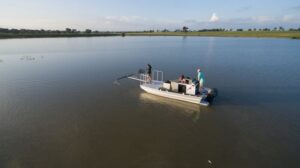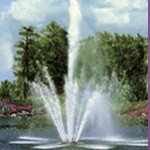By Matt Ward
Spring will be here before you know it, along with better fishing weather. Now is the time to make sure your pond or lake delivers a top-notch fishing experience this year.
Smart pond and lake owners are choosing what fishery management approaches will make their oases meet their hearts’ desire, whether stocking with trout, creating a trophy bass pond, or adding the right forage fish for the best fish growth.
Fishery experts report that Texas farm ponds aren’t managed at their highest potential for fish production. Pond health and maintenance should be a top priority for landowners, according to the Texas A&M AgriLife Extension Service.
So while you might be thinking about fish stocking for your pond or lake this year, there are other important maintenance steps to take to ensure the fish are plentiful and biting in months to come.
If you were underwhelmed with your lake’s performance in 2020 or are unsure of the current status, now is the time to be considering what approach will yield best outcomes in 2021.
Here are fishery management steps you should be looking at now:
Electrofishing Survey
If your pond or lake is geared toward fish quality, it’s highly recommended that you start with an electrofishing survey, which typically begin in February. It’s an excellent tool for correcting an out-of-balance pond.

These electrofishing surveys accurately assess current forage and sport fish populations and quantify wintertime Cormorant or otter damage. Fish populations also are sampled to determine species, size, relative abundance and growth rates.
It’s important to use a top-of-the-line electrofishing boat to identify stunted fish or unwanted species, which can be easily and quickly removed as part of this service. An electrofishing survey is a standard scientific survey method that causes no long-term negative effect to the fish population in your pond or lake.
Performed correctly, the fish are stunned briefly, examined for species to determine abundance, population density, weights and measurements, and then quickly returned to their normal state.
An electrofishing survey is the reference point for a long-term pond management plan, providing clues for corrective stocking and harvest recommendations. While electrofishing surveys are used on established lakes to determine and diagnose problems, they’re also used as a routine management tool to identify issues before they become large and expensive problems.
Our fish experts can conduct an electrofishing survey for you using state-of-the-art techniques and equipment. Click here to learn more.
Pond stocking
Supplemental and new forage pond stocking starts as early as January and helps reconcile losses from avian predation and establish proper predator to prey ratios going into summer.
 What kinds of fish will work best in your body of water involves many variables, including your own goals for your pond or lake. For example, you need to carefully assess the impact of introducing non-native species into your pond. It’s important to be aware of the fish types that can live together in harmony so your pond can sustain a healthy eco-system.
What kinds of fish will work best in your body of water involves many variables, including your own goals for your pond or lake. For example, you need to carefully assess the impact of introducing non-native species into your pond. It’s important to be aware of the fish types that can live together in harmony so your pond can sustain a healthy eco-system.
Therefore, pond stocking must start with a plan and using professional guidance is key.
This important part of any pond management program must be handled with skill and precision to ensure that the results live up to your expectations and can be maintained over the long term.
Small ponds and large lakes must be stocked and managed in different ways. Factors such as location, health and condition also must be considered. Jumpstart pond stocking rates are also different from maintenance stocking rates, and the amount of maintenance stocking varies significantly based on the size of the lake and other factors.
It’s also important to understand spawning and other characteristics of specific fish you might want to stock. For example, rainbow trout will not spawn in Texas ponds. Meanwhile, spawning for our native strain of largemouth bass can begin as early as February depending on the temperature.
Control of pond weeds

Vegetation control should be done starting early in the pond weeds growing season and follow-up treatments should be done throughout the season.
Your lake or pond is basically a small ecosystem that is cut off from many of the elements that maintain balance in natural waters. An array of products, equipment, herbicides, lake dyes and algaecides can help rid your property of nuisance aquatic plants or issues with floating, submerged or emergent pond weeds.
Some pond weeds can take over lake shorelines, making it difficult to fish from the shoreline or swim. Having some vegetation is beneficial for fish and other aquatic organisms. But too much vegetation can negatively impact aquatic organisms through a process called cultural eutrophication.
For a chemical-free approach, you can consider vegetation control as part of your pond stocking plan, such as stocking triploid grass carp and tilapia, which are among the most popular biological alternatives for removal of pond weeds. In addition, there are nutrient precipitation, fertilization regimes, and aeration systems to promote plankton blooms that improve the health of your pond and can shade out many pond weeds.
Aquatic vegetation is the cause of 80 percent of low dissolved oxygen fish kills in Texas. And the issues are complex enough that expert advice is recommended.
Our experts can help you assess the right approach to controlling vegetation in your pond or lake.
Liming and fertilizing
Just as you would fertilize fields to increase crop yields, you should fertilize a pond or lake to provide phytoplankton with adequate nutrients for fish growth and that should start now.
Proper pond fertilizing increases food availability throughout the food chain and indirectly increases the total amount of fish a pond can support. Ponds should be limed before fertilizer is applied, which is important because it increases pH and alkalinity. Even without fertilization, this may improve available nutrients which can support a phytoplankton bloom.
Harmful algae blooms and other harmful algae are becoming increasingly prevalent. To avoid such problems, you should consider establishing a long-term nutrient sequestration program.
This is not as easy as it sounds. Many lake and pond owner attempt to take this on themselves, but it really helps to bring in professionals to assist with an overall plan.
Learn more about liming and fertilization by clicking here.
Aeration & fountain maintenance
July and August can be deadly if dissolved oxygen levels are not where they should be, according to the Texas Farm Bureau.
 In order to avoid catastrophe, pond and lake owners currently should be inspecting aeration and fountain maintenance or considering their implementation now. Repairs could address obvious signs of wear or just the cleaning of filters and screens.
In order to avoid catastrophe, pond and lake owners currently should be inspecting aeration and fountain maintenance or considering their implementation now. Repairs could address obvious signs of wear or just the cleaning of filters and screens.
We offer a range of aeration systems and fountain systems for ensuring your pond’s oxygen levels are optimal.
Why Choose Lochow Ranch
Serving Texas, Oklahoma, Arkansas and Louisiana, Lochow Ranch Pond & Lake Management proudly puts more than two decades of experience to work for you. Our team includes biologists, technicians and other professionals with deep expertise in pond and lake management services.
Check us out if you are considering building a lake, looking for pond stocking services, to buy fish for a pond, or getting professional pond management and maintenance or fishery management. Our services include lake design, pond construction, pond renovation, pond water testing, electrofishing, pond stocking, control of pond weeds, and pond liming and fertilizing. Let us help you build your dream pond that will delight your family and friends for generations to come.
Click here to get in touch to get started today.
Matt Ward is a Fishery Biologist for Lochow Ranch Pond & Lake Management. He has a Master of Science in Biochemistry from Texas A&M University and has worked in fisheries management in Texas for 15 years. He brings a passion for good science and an interdisciplinary approach to the natural sciences to help property managers steward their aquatic resources and achieve management objectives.

Recent Comments